Every seed at the ICRISAT genebank, is like a piece of gold
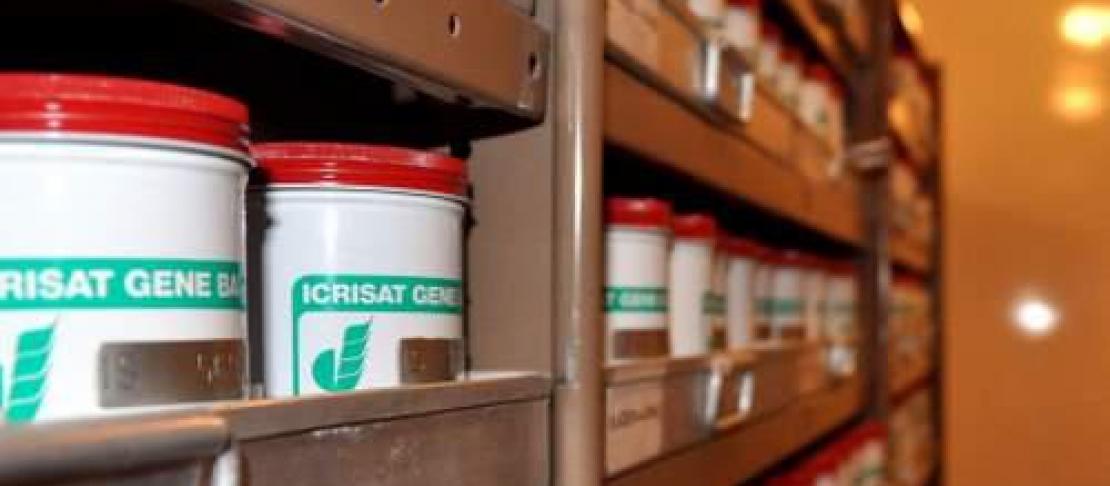
“Germplasm collection”, “allele diversity”, “Crop registers”, might sound like mystic academic terms to you. Likewise for me, I could hardly link them into the discussion about climate change and food security…. Until I visited the genebank on the ICRISAT campus near Hyderabad in India.
The International Crops Research Institute for the Semi-Arid Tropics (ICRISAT) is a non-profit organization conducting agricultural research for development in Asia and sub-Saharan Africa. ICRISAT is part of a consortium of similar agricultural research centers supported by the Consultative Group on International Agricultural Research (CGIAR).
…and they have a bank. Not to store money or gold, but to safeguard something much more precious: the genetic material – or “germplasm”- of 119,000 “accessions” -or varieties- of sorghum, pearl millet and six other types of small millets, chickpea, pigeonpea and groundnut, collected from 144 countries.
“Genetic diversity is key to the future”
Over thousands of years, different food crops have evolved into zillions of different varieties, either grown as a cultivated crop, or flourishing in the wild. Each variety differs from the next in the way it naturally adapted its genetic code to the environment it grows in: how it deals with drought or a high soil salinity, how it built up resistance to certain pests. Many differ in their yield, size, leaves or roots.
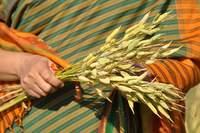 But, as Bob Dylan sung: “Times are a-changing”. Farmers now often concentrate on monocultures, or grow only a selection of high yielding crops. Commercial companies have been “successful” in promoting certain varieties, which farmers adopted quickly, and –thanks to globalization- were spread widely. Understandably so, as “the world needs to produce more food”. However, all of this became nefast for the bio-diversity: Today, the rate in which traditional seed varieties disappear, is higher than ever.
But, as Bob Dylan sung: “Times are a-changing”. Farmers now often concentrate on monocultures, or grow only a selection of high yielding crops. Commercial companies have been “successful” in promoting certain varieties, which farmers adopted quickly, and –thanks to globalization- were spread widely. Understandably so, as “the world needs to produce more food”. However, all of this became nefast for the bio-diversity: Today, the rate in which traditional seed varieties disappear, is higher than ever.
This stands in stark contrast with the demand for more and specialized seed varieties, adapted to the ever changing weather patterns. If the genetic biodiversity disappears, where will we find the seed varieties helping farmers to cope with future environmental changes?
Unless if we safeguard our existing seed varieties for the wide range of crops the world grows, we will no longer have the genetic material to re-generate seeds adapted to the future climate changes.
And that is where genebanks come in. Genebanks like the one I was standing in this morning, at ICRISAT.
ICRISAT’s genebank: saving our past, for our future.
 In two large earthquake proof and environment controlled “vaults”, ICRISAT’s genebank is safeguarding the bioversity of sorghum, millet, chickpea, pigeonpea and groundnut. These crops might not be staple food such as wheat, maize or rice, but they are just as essential to a balance diet of the world’s ever growing population, particularly for the poorest of the poor in the semi-arid tropics.
In two large earthquake proof and environment controlled “vaults”, ICRISAT’s genebank is safeguarding the bioversity of sorghum, millet, chickpea, pigeonpea and groundnut. These crops might not be staple food such as wheat, maize or rice, but they are just as essential to a balance diet of the world’s ever growing population, particularly for the poorest of the poor in the semi-arid tropics.
It is a common misunderstanding that malnutrition is only caused by the lack of SUFFICIENT food to eat. More often than not, malnutrition is caused by a lack of THE RIGHT food, containing all nutrients, like proteins and vitamins which make a balanced diet.
Take the case of chickpeas: did you know that chickpeas make up for more than 20 percent of world pulse production? Did you know that chickpeas contain 25% proteins, the maximum provided by any pulse? While in the developed world, the protein intake comes mostly from fish or meat, in the majority of the developing countries this is not the case: Fish or meat is a luxury commodity, and people have to resort to pulses like chickpeas for their daily protein intake. That makes chickpeas an important crop in the global fight against hunger.
To safeguard the variety of commodities like chickpeas, allowing researchers to re-create old varieties or generate new varieties, adapted to the ever changing climate, the genetic material needs to be saved. And that is the role of a genebank.
Over the past thirty years, the ICRISAT genebank collected and stored over 20,000 different varieties of chickpeas, collected from 60 countries, making it the largest of its kind in the world. And not only for chickpeas, but for the more than 119,000 varieties of the 11 crop types it caters for.
The genebank collects and stores seeds
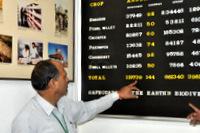 Sube Singh, a lead scientific officer, who has worked in ICRISAT’s genebank since 1978, explains: “The collection, selection and storage of the genetic material of our seeds is an elaborate process. It is not just a matter of taking just “any” seed, and storing it in a bag.
Sube Singh, a lead scientific officer, who has worked in ICRISAT’s genebank since 1978, explains: “The collection, selection and storage of the genetic material of our seeds is an elaborate process. It is not just a matter of taking just “any” seed, and storing it in a bag.
We get seed material, sometimes as little as 100 seeds in a single sample. First we verify the characteristics of that particular variety: its origin, the growing period, the yield, resistance to pests or drought, and hundreds of other characteristics which make the genetic difference between the varieties. If we find we don’t have this variety yet, the seed sample goes into a quarantine area where we ensure the seed is free of any contamination or pest, as this could affect all other seeds we store or cultivate. After it is certified to be safe, we can process it further.”
“But the work does not stop there”, Mr Singh continues: “An extensive biochemical analysis gives us further details on the seed sample’s characteristics, which are all stored in a central database. For some seeds, we need to regenerate it: if we only have a limited quantity, we reproduce new seeds from the sample we received, either in quarantined greenhouses or on our test fields.”
After a drying process, seeds are then stored into the “active collection”, an isolated vault storing the seeds in bottles, at +4 o C, where they can be kept for 25 to 30 years. Each seed variety is checked every five years to see if its capacity to reproduce is not degrading. The second vault, the “base collection”, stores seeds at -20 o C, where they can be kept for 100 years.
But the strength of a genebank is not in storing alone.
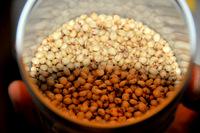 When I ask Sube what the real value of genebank is, his eyes light up…: “The more seeds which are re-used, the better. That is our real success factor”. He gave the example of Iraq and Afghanistan where the war wiped out those two countries’ genebank. There was no way to find the “core” seeds of the local food stocks anymore. This would have been catastrophic for the agriculture and the population as a whole, if it was not for the ICRISAT genebank: Local varieties of these crops were stored at the bank before the war. Samples were “repatriated” to both countries so the seeds could be regenerated, and distributed “en masse” to the farmers.
When I ask Sube what the real value of genebank is, his eyes light up…: “The more seeds which are re-used, the better. That is our real success factor”. He gave the example of Iraq and Afghanistan where the war wiped out those two countries’ genebank. There was no way to find the “core” seeds of the local food stocks anymore. This would have been catastrophic for the agriculture and the population as a whole, if it was not for the ICRISAT genebank: Local varieties of these crops were stored at the bank before the war. Samples were “repatriated” to both countries so the seeds could be regenerated, and distributed “en masse” to the farmers.
But it is not only Iraq and Iran. In the past thirty odd years, the ICRISAT genebank has distributed 1.4 million samples to 143 countries. Some of these varieties would have been lost for ever, if it wasn’t for the ICRISAT genebank.
Creating a future, thanks to the past.
Doomsday-like scenarios where countries loose their genetic material might be one –rather negative- example showing the importance of genebanks. A much more common use of biodiverse genetic material, is to generate new varieties, adapted to newly emerging needs.
Taking the example of chickpeas again, research showed that several accessions (or varieties) from a mini-core collection at the genebank were more drought resistant than the common “ICC4958” variety, widely used in semi-arid areas. Using the ICRISAT seed collection, new and better varieties were created and distributed.
“Drought resistance” is just one of the many qualifiers. Imagine what the impact is when one wants to create new varieties adapted to warmer or colder climates, resistant to pests, or to salinity…
“Salinity is a good example”, says Sube. “The 2004 tsunami contaminated millions of hectares of agricultural land with sea water. All of sudden, farmers found that their traditional seeds could no longer grow in this saltier environment. Through the genebank, we generated varieties which were adapted to their changed environment: varieties with a higher salinity resistance.”
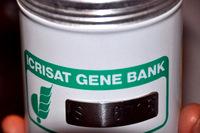 As Sube was explaining me the mechanics and process of the selection and storage, the image of a coin collector came to my mind. I asked him: “An antique coin collector often has one piece he is particularly proud of, do you have one seed variety or one specific ‘find’, which you cherish like gold?”.
As Sube was explaining me the mechanics and process of the selection and storage, the image of a coin collector came to my mind. I asked him: “An antique coin collector often has one piece he is particularly proud of, do you have one seed variety or one specific ‘find’, which you cherish like gold?”.
Sube smiled: “New varieties are created every day. One hundred year old samples, or a variety cultivated last year, for us, all have the same value, all are equally precious. For us, every seed sample is like gold”.
The way ahead for researchers and smallholder farmers facing current and coming challenges posed by climate change lies in learning from each other while sharing knowledge and experiences.
Photos in this article by Peter Casier.
